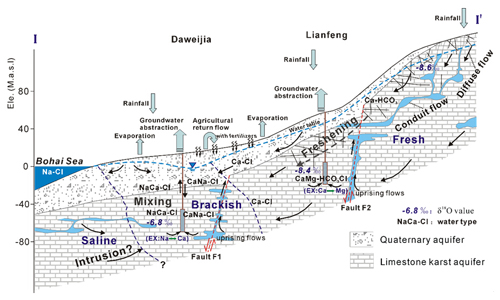Seawater intrusion (SWI) due to groundwater over-exploitation has led to salinization of fresh groundwater in coastal areas, threatening numerous water supply wells worldwide. With agricultural-industrial-urbanized development in the coastal regions, it is imperative to understand the major hydrological and chemical processes (not only SWI) responsible for modifying the groundwater quality in the coastal aquifers.
A research team led by associate professor HAN Dongmei and Prof. SONG Xianfang in Institute of Geographic Sciences and Natural Resources Research (IGSNRR), Chinese Academy of Sciences, achieved an important progress on identifying the anthropogenic and natural inputs for modifying groundwater hydrochemistry in the coastal aquifers of north China.
The study focuses on the coastal aquifers in the Dalian area, northeastern China. The researchers investigated the physical flow and concomitant hydrogeochemical processes by systematically analyzing hydraulic, geochemical and isotopic data. The partially positive correlation between δ18O values and Total dissolved solids (TDS) concentrations of groundwater, the high NO3 concentrations and sulfate isotope mass balance suggest that the present-day elevated salinities in groundwater are more likely due to agricultural activities via irrigation return flow.
Seawater mixing with fresh groundwater is another important source in the carbonate aquifer where formerly intruded seawater may still reside in immobile zones. The results point to an alarming level of impact from the local intensive agriculture on the groundwater system, a widespread problem throughout China.
The good inverse relationship between groundwater mean residence time (MRT) (92–467 years, determined using 3H and CFCs) and the NO3 concentrations in the shallow Quaternary aquifers indicates that elevated nitrate concentrations are attributable to more recent recharge for shallow groundwater.
The groundwater MRTs in the carbonate aquifers are 8–411 years and has no significant relationship with the NO3 concentrations, and this indicates that nitrate in the complex carbonate aquifer without denitrification effects could transport for tens of years and accumulate in the groundwater irrigation cycle.
 |
|
Cross section showing the conceptual hydrogeological and hydrogeochemical model derived from hydrological, geochemical and isotope data. Arrows in aquifers indicate groundwater flow direction. EX-cation exchange.(Image by HAN Dongmei) |
The related articles as follows:
l Han D.M.*, Song X.F., Currell M.J., 2016. Identification of anthropogenic and natural inputs of sulfate into a karstic coastal groundwater system in northeast China: evidence from major ions, δ13CDIC and δ34SSO4. Hydrol. Earth Syst. Sci., 20, 1-17. doi:10.5194/hess-20-1-2016.
l Han D.M.*, Post V.E.A., Song X.F., 2015. Groundwater salinization processes and reversibility of seawater intrusion in coastal carbonate aquifers. Journal of Hydrology. 531(3):1067-1080.
l Han D.M.*, Cao G.L., McCallum J., Song X.F., 2015. Residence times of groundwater and nitrate transport in coastal aquifer systems: Daweijia area, northeastern China. Science of the Total Environment. 538(15):539-554.